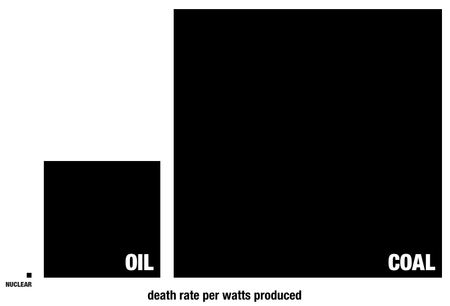
Is that a shocking graphic or what? If you can’t quite make out the word on the far left, it’s “Nuclear”. This chart compares the number of deaths generating nuclear, oil, and coal-based power on a per-watt basis. Seth Goodin shared this and I found it quite profound. I’ve been a proponent of nuclear power for a few years now, and this chart only further drives home the truth. Coal, and oil, are destructive, messy, finite energy sources and we need to move toward nuclear power to generate our electricity. Yes, the problems with the nuclear power plants in Japan are scary, but the hard reality is that even when incredible disasters occur like the 8.9 earthquake and the resulting tsunami, modern nuclear power plants are still fairly safe. There were some lessons that were learned in Japan – such as placing the back-up power generators underground, along with their fuel supply – that will help ensure nuclear power is safer for everyone in the future.
Particularly you as a technology-savvy guy should raise your ears when someone says “100% reliable” as you will be aware of the fact that anything that can go wrong will eventuelly go wrong. And I believe that a technology shouldn’t be used when there’s still no concept of securley storing the used nuclear fuel for the generations needed for them to lose their danger potential.
I’m also slightly surprised that you don’t bemoan a part of your beloved Japan to become inhabitable for a long time.
You don’t have to securely store the fuel if you can reuse it, which you can. You can reuse spent fuel rods for years and still get plenty of power from them and they never have to be stored anywhere. The problem is that the nuclear industry, at least in the US, has been kneecapped by Three Mile Island and Jimmy Carter. TMI was never the disaster everyone wanted it to be, and yet here we are with barely any advancements in nuclear power since the accident.
Reprocessing spent rods can recover almost 100% of their usable power and you wouldn’t have to store them anywhere. What’s wrong with that?
I think the reason that people are scared of nuclear is because they constantly have idiots screaming in their ear about how there would be a mushroom cloud if one “blew up” (can’t happen) and how a plant would burn a hole to the core of the earth and destroy the planet in a meltdown (also can’t happen), and how Chernobyl was a warning (even though there isn’t a modern reactor on the planet that uses the outdated technology that Chernobyl did; an accident caused by human ignorance and poor equipment).
Nothing is perfect. Nuclear isn’t. Coal isn’t. Solar isn’t. Wind isn’t. We can’t let the perfect be the enemy of the good.
I don’t agree that it’s 100% reliable – nothing is – but nuclear technology, and safety, has come a long way in the past 20 years…from what I can tell at least. I don’t know much about the the nuclear fuel disposal, so I can’t speak to that point – I have heard, however, that given the small mass of the waste compared to the amount of energy it generates, simply storing it in a secure facility is a reasonable option.
As for part of Japan being inhabitable, to be honest, since I didn’t visit that part of Japan I don’t feel a very personal connection to it – if this had happened in Kyoto for instance, I’d feel differently. I don’t mean for that to sound callous or cold – I mourn for the loss that the Japanese have suffered – but it’s the truth.
I don’t think nuclear power is without risks, but when you look at the deaths from coal and oil – yikes – it’s hard to argue those are “safe” technologies.
There are some amazing advancing in smaller, safer nuclear “plants:
http://en.wikipedia.org/wiki/Toshiba_4S
“We can’t let the perfect be the enemy of the good.”
Well said Vinny!
Here’s another stat:
Deaths from Tsunami: 10-20k
Deaths from Fukishima: 0
I suppose there will be causes of death linked to Fukishima in the future, but I suspect it will be a lot less than the tsunami.
Bonus stats: http://xkcd.com/radiation/
Great find Lee – that’s an impressive chart! Talk about a lot of work…